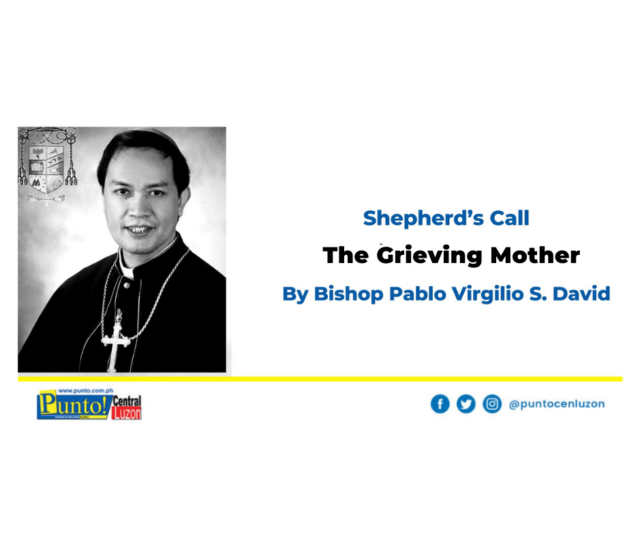I SHARED these thoughts a few months ago to our family when I celebrated Mass for my sister-in-law’s first death anniversary. I realized that the thoughts that I had shared then are also very appropriate for today’s Memorial of Mary, Our Lady of Sorrows.
The image that we get of Mary in today’s Gospel is that of a GRIEVING MOTHER, isang inang nagluluksa, which is how I propose to translate MATER DOLOROSA, the title by which we commemorate Mary today.
In Kapampangan we refer to the first death anniversary as “LUKAS PALDAS”. Literally, it means removing one’s grieving clothes (Hubad Luksa). In Tagalog, they call it “BABANG LUKSA” (Putting down the grief, allowing grief to descend). I asked a friend of mine from Bulacan why they use BABA instead of HUBAD. He said, grieving for them is not just something you wear and easily remove like clothes. When you lose someone you really love, grief is like something that envelopes and permeates your whole being. It takes a lot more to put it down or let go of it.
This makes me understand why we Filipinos have a different way of celebrating Easter. The Easter eggs and bunnies of Europeans and Americans do not mean much to us. So, we have reinvented our Easter and enculturated it as something like our “Babang Luksa,” our Pinoy ritual of putting an end to the grieving process. We prefer to dramatize it through our traditional Salubong, the encounter between the Risen Jesus and the Sorrowful Mother, facilitated by the coming down of an angel. The angel’s task is to remove the black veil that covers the face of Mary to allow her to share in the joy of her Risen Son.
Last Easter Vigil, because we were still under ECQ and were not yet allowed to hold public religious gatherings, I myself played the role of the angel that performed the ritual of removing the black veil of grief from the head of the Sorrowful Mother. When I did it, I imagined her to be our country or the whole world today, knowing how a veil of grief had descended upon us and covered or lives since the start of the pandemic crisis that had locked us all down in our homes.
Imagine how much more painful the grieving must have been for people who have lost their loved ones to the Covid-19 in the past few weeks? Imagine the thought of letting your loved one suffer and die alone in a hospital ICU? Imagine not being allowed to even kiss or touch them? Imagine saying goodbye to them through a cellular phone? Not being able to have a proper wake in order to mourn together as a family? Having to have your loved one cremated within 24 hours?
Pope Francis
I don’t know why we often find ourselves apologizing when grief makes us break into tears. One of the scenes that we will never forget about that time when Pope Francis visited the Philippines took place at the parade grounds of UST. Remember that girl who broke down before him after asking the question “why does God allow young people to suffer abuse?” The Pope himself cried and embraced the little girl. Later he said, “Sometimes God helps us to see more clearly with eyes washed by tears.” Victor Hugo said something to that effect too in his novel Les Miserables, he said, “Those who do not weep do not see.”
In the introduction to his sermon on the mount, Jesus says, “Blessed are those who grieve, they shall find consolation.” Imagine calling grief a blessing? But maybe that is the paradox of it. Only those who have loved can truly grieve. I don’t know if I’ve ever mentioned to you that Italian writer, Carlo Rovelli in his book entitled, The Order of Time, who gives a positive meaning to grieving. He says, “It isn’t absence that causes sorrow (or grieving). It is affection and love. Without affection, without love, such absences would cause us no pain. For this reason, even the pain caused by absence, is, in the end, something good and even beautiful, because it feeds on that which gives meaning to life.” Only those who love can truly grieve.
Only those capable of compassion can be stricken with sorrow for the pain of another person. My honest feeling is that what the Blessed Mother grieves about in our day and age is when people cannot even grieve anymore; when people just don’t care. When they remain unaffected by the suffering of others.
When the Papal Nuncio visited us in the Diocese of Kalookan, he retold to us the story of our beloved patron saint, San Roque—who lived in the time when Europe was stricken by a deadly plague. At some point in his homily, he shifted to our own times and said, modern people are confronted by an even more serious kind of plague: the plague of indifference.
He alluded to the story of Cain and Abel, where, he said, it is the Lord who grieves. What affects God more deeply is Cain’s incapacity to grieve about the terrible thing that he had done to his brother. God is grieved by Cain’s answer to his question, WHERE IS YOUR BROTHER? When Cain replied and said, AM I MY BROTHER’S KEEPER? What he was actually saying was, WHAT DO I CARE?
Indeed, It is indifference that kills our hope— the very incapacity itself to grieve. And so, you see, why we celebrate the image of Mary as a grieving mother. Mary’s grief is the sorrow of love that brings hope with it. Remember what Jesus says in John 16:20-22: “Amen, amen, I say to you, you will weep and mourn, while the world rejoices; you will grieve, but your grief will turn into joy.”
(Homily for 15 September 2020, Tuesday of the 24th Week in Ordinary Time, Memorial of Our Lady of Sorrows, John 19:25-27)





